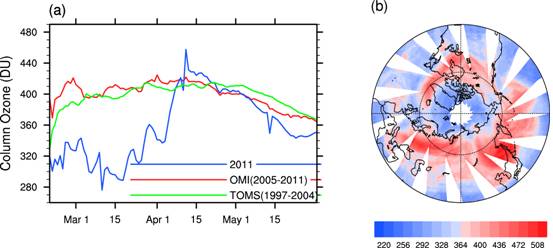Hu Yongyun and Xia Yan
Laboratory for Climate and Ocean-Atmosphere Studies, Department of Atmospheric and Oceanic Sciences, School of Physics, Peking University, Beijing 100871, China
Record ozone loss was observed in the stratospheric Arctic in the spring of 2011 (see attached Figure below). In the present work, we show observational evidence that the record loss of Arctic ozone is due to the extremely cold and persistent stratospheric polar vortex in the winter of 2010–2011. The polar vortex was as usual in early winter, but was intensified twice in middle January and middle February, respectively, and remained anomalously strong and stable until early April, 2011. Record low polar temperatures and record high subpolar zonal winds occurred in February and March. Stratospheric wave activity was anomalously weak because waves were refracted equatorward by the anomalously strong polar night jet. With such an extremely cold and isolated environment, Arctic stratospheric ozone was largely depleted in March and early April, 2011. Corresponding to Arctic ozone depletion, the stratospheric Northern-Hemisphere Annular Mode (NAM) displayed anomalously strong high-polarity, and the positive stratospheric NAM propagated downward and led to anomalously strong positive NAM in the troposphere and near the surface.
Citation: Hu, Y., and Y. Xia, 2013: Extremely cold and persistent stratospheric Arctic vortex in winter 2010–2011. China Science Bulletin, doi: 10.1007/s11434-013-5945-5.

Figure caption:(a) Time series of area-weighted total column polar ozone between 70° and 90°N for the spring of 2011 (blue), the climatological mean from TOMS (green), and the climatological mean from OMI (red), and (b) total column ozone in Northern-Hemisphere high-latitudes on March 7, 2011.
